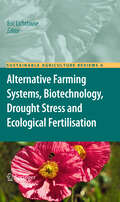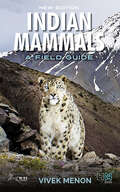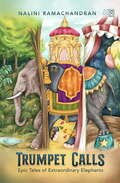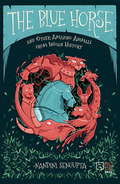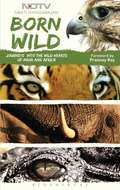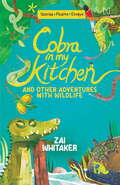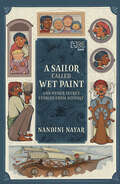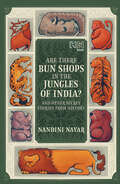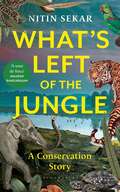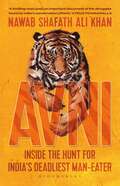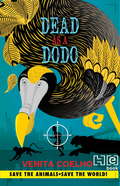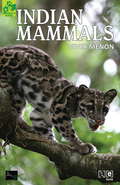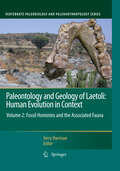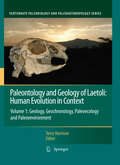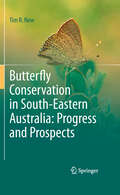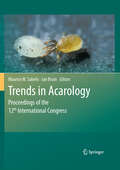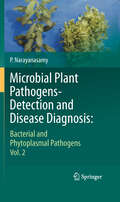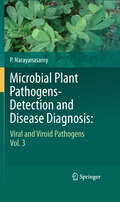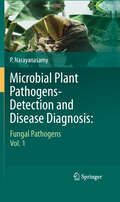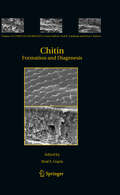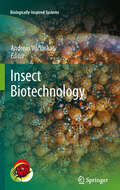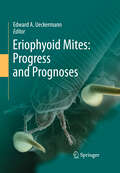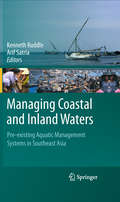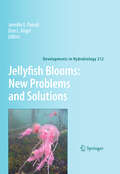- Table View
- List View
Alternative Farming Systems, Biotechnology, Drought Stress and Ecological Fertilisation (Sustainable Agriculture Reviews #6)
by Eric LichtfouseSustainable agriculture is a rapidly growing field aiming at producing food and energy in a sustainable way for our children. This discipline addresses current issues such as climate change, increasing food and fuel prices, starvation, obesity, water pollution, soil erosion, fertility loss, pest control and biodiversity depletion. Novel solutions are proposed based on integrated knowledge from agronomy, soil science, molecular biology, chemistry, toxicology, ecology, economy, philosophy and social sciences. As actual society issues are now intertwined, sustainable agriculture will bring solutions to build a safer world. This book series analyzes current agricultural issues, and proposes alternative solutions, consequently helping all scientists, decision-makers, professors, farmers and politicians wishing to build safe agriculture, energy and food systems for future generations.
The Amazon Várzea: The Decade Past and the Decade Ahead
by Miguel Pinedo-Vasquez, Mauro L. Ruffino, Christine Padoch and Eduardo S. BrondízioThis book takes a multi-disciplinary and critical look at what has changed over the last ten years in one of the world's most important and dynamic ecosystems, the Amazon floodplain or várzea. It also looks forward, assessing the trends that will determine the fate of environments and people of the várzea over the next ten years and providing crucial information that is needed to formulate strategies for confronting these looming realities.
Indian Mammals: A Field Guide
by Vivek MenonA fully updated edition of the bestselling guide to the mammals of IndiaCovering the rich diversity of mammal species in India, from tigers, elephants, rhinoceros and whales to primates, rodents and bats, Indian Mammals is field-ready, illustrated and comprehensive in approach. Rigorously researched, Indian Mammals reflects a lifetime's work by Vivek Menon, one of India's leading authorities on Indian wildlife. Planned for easy reference, this compact guide is the essential resource for wildlifers of any age, including animal watchers, eco-tourists and active conservationists. * More than 440 species of both terrestrial and aquatic mammals with introductory pages on each order * Describes key identification features, biometrics, behaviour, social strategies, habitat and distribution * Over 1,000 carefully curated photographs and supplementary illustrations * 140-plus updated distribution maps * Colour tabs for sections to facilitate ease of use * Live-action field notes from the author
Trumpet Calls: Epic Tales of Extraordinary Elephants
by Nalini RamachandranTo some, elephants are the guardians of forests; to others, they are sacred symbols - worthy of being worshipped. They were comrades-in-arms to kings and queens in one time, and objects of entertainment in another.Drawing from contemporary accounts, world history and mythologies, this enlightening book, peppered with fascinating facts and gorgeous illustrations, explores the complex relationship between elephants and humans across the ages.Here, you will meet elephants who can fly and vanquish nightmares, turn the tide of a battle, trek up mountains and swim like champions, avenge wrongs and form lifelong bonds.Funny, joyful, often profoundly moving and sometimes downright heartbreaking, Trumpet Calls takes you on the wild and wondrous trail of the most majestic creature on earth.
The Blue Horse and Other Amazing Animals from Indian History
by Nandini SenguptaIt’s not just humans who make history, you know. So move over, chroniclers and historians. For centuries, we’ve been ignored, forgotten, occasionally footnoted (thanks a lot). It’s time we took centre stage. Strongest allies, faithful friends…we’ll even go so far as to say we were the soulmates of great kings and queens, princes and princesses, warriors and administrators. From saving their lives (while putting ours at risk) and leading them to victory in war to being a constant source of joy and love, we’ve done it all. Take a tour of Akbar’s dazzling court with his favourite cheetah, Samand Manik. Learn about the heroic battle of Haldighati – straight from Chetak’s mouth. Find out what Chhatrapati Shivaji was really like – from his dog, Waghya. Full of daring exploits, epic romances and heart-wrenching moments, these underdog (oh calm down, Bucephalus, it’s just a term!) stories are unlike anything you’ve ever read before!
Born Wild: Journeys into the Wild Hearts of India and Africa
by Swati ThiyagrajanFeel the magic of the wild come alive with the book you're holding in your hand. Come, walk with the author through mesmerizing wildlife landscape - from the length and breadth of India's forests and sanctuaries in Madhya Pradesh, Bihar, Rajasthan, the Western Ghats, Karnataka and Orissa to Rwanda, Namibia, Botswana and South Africa. Through brilliantly vivid experiences Swati recounts fascinating insights into wildlife sighting and conservation efforts around the world, covering a wide array of wildlife including tigers and gorillas, lions and elephants, sloth bears, sea turtles and sharks, crocodiles, pelicans and penguins.
Cobra in My Kitchen and Other Adventures with Wildlife
by Zai WhitakerROAR! HISS! SQUEAK! NYUK-NYUK!Wildlife sure sounds fun, doesn't it? Explore the wild with Zai Whitaker, an eager adventurer raised among India's pioneering conservation heroes! Together with Romulus Whitaker, the 'Snake Man of India', Zai developed the Madras Crocodile Bank, to research and conserve crocodiles and other 'herps'. From living with cobras as to hatching sea turtles and from watching birds to stalking termites, Zai has a long and thrilling trail of escapades. Her stories, poems and real-life accounts take you from Chennai to the Western Ghats, from the Andaman and Nicobar Islands to Papua New Guinea, and beyond into her wildly wonderful imagination! Beautifully illustrated, Cobra in my Kitchen and Other Adventures with Wildlife introduces you to the fascinating side of wriggly snakes, jumpy frogs, lively lizards, colourful chameleons and even a tiger or two, along with many more unmissable adventures! Hop on to this sensational safari of discoveries for children and the whole family!
A Sailor Called Wet Paint and Other Secret Stories from History
by Nandini Nayar"What can a lady in a thin sari do to survive in COLD England?How will a ship's crew RETURN home without any money?When did the young ayah last see her OWN family?And why, oh why, did the sailor write WET PAINT in a young girl's diary?Nannies and sailors taken 4,000 miles away to England to work...it's the same SORRY tale. Often ABANDONED, they have to find their own way across the sea, back home to India! It's upsetting. It's shocking. It's breaking our hearts. What are we to DO? Well, here are stories - a whole SHEAF of them about AYAHS in a foreign land and the Indian crew of LASCARS on ships, questioning why the British don't treat these people kindly. Asking to give them the home, the care and the freedom they deserve. But is ANYONE listening? Are YOU? "
Are There Bun Shops in the Jungles of India? And Other Secret Stories from History
by Nandini NayarWhen was the last time the MIGHTY tiger roamed freely under the open sky?What is the SLEEK leopard from sunny India doing in FREEZING England?How will the HUGE rhinoceros stay in a SMALL, cramped cage?And why, oh why, is the ENORMOUS elephant eating tiny BUNS in the zoo?Leopards and cheetahs, bears and antelopes, monkeys and deer...it's the same SORRY tale. These animals from India have been CAGED for the amusement of people - to be prodded and poked and teased! It's upsetting. It's shocking. It's breaking our hearts. What are we to DO? Well, we have written letters - a whole SHEAF of them - to the owners of menageries and the zoo, asking them to STOP this cruelty NOW. To give the animals the food, the care and the freedom they deserve. But ARE they reading them? Are YOU?
What's Left of the Jungle: A Conservation Story
by Nitin SekarIndian officials estimate that over half a million families lose crops or property to wild elephants a year. Akshu Atri, born and raised in Buxa Tiger Reserve, is one such victim. Elephants have destroyed his kitchen, regularly take over half of his annual crop yield, and have even killed some of his neighbours.Akshu could hate elephants, but he doesn't - neither does his family nor most of their community. By telling Akshu'sstory - of his childhood destitution, family tragedies, romantic pursuits, entanglements with poachers and smugglers, and his tumultuous rise out of poverty - What's Left of the Jungle unravels the complex affection that rural Indians have for jungle wildlife.Akshu's story can help us understand both why some of the tropics' most crowded landscapes still host the world's most stunning wildlife - and what we might need to do to keep it that way.
Avni: Inside the Hunt for India's Deadliest Maneater
by Nawab Shafath KhanIn 2018, news that a tigress named Avni had been shot dead in Yavatmal, Maharashtra, went viral online. When the saga played out on national media, the hunters were denounced as ruthless and bloodthirsty. However, there was more to the story.For, the tigress T1, as Avni was originally named, was a man-eater blamed for 13 killings. For over two years, she had spread fear over 150 square kilometres of rural Yavatmal, prompting more than 10,000 people to shut themselves inside their homes at night. Several attempts by the forest department to capture the animal alive had proved futile, and the authorities finally brought in hunters as a last resort.Now, for the first time, Nawab Shafath Ali Khan, the man who led the operation to neutralise T1, reveals the true story behind the biggest man-eating tiger operation in post-independent India. While painting a deeply empathetic portrait of the complexities of human–animal conflicts, Khan also raises important questions about the state of conservation in India.Heart-stopping and eventually tragic, Avni tells the story of a tigress pushed to her limit and of the man tasked with stopping her at all cost.
Dead As A Dodo
by Venita CoelhoMISSION DEAD AS A DODO Mission Brief: Somebody is on an extinction operation, stealing all the last specimens of highly endangered species. This mysterious crook has somehow managed to discover the impossible – a living specimen of Raphus cucullatus, aka, the dodo. Yes, the same flightless bird that was hunted to oblivion in Mauritius more than 300 years ago! This dodo has become the single most priceless creature on the planet and it must be rescued immediately. Without delay, Animal Intelligence Agency agents are assigned to this urgent mission. NOTE: The Animal Intelligence Agency is a multi-species nongovernmental agency. Specially trained Animal and Human agents work undercover to save animals and save the world. Some of them have a licence to kill. Agent no. 002 Species: Panthera tigris tigris Name: Bagcha Currently the only agent with a licence to kill. He is the most dangerous and experienced operative, with the scars to prove it. Agent no. 015 Species: Semnopithecus entellus Name: Kela This operative was formerly a disgraced agent, stripped of his number. However, after his sterling performance in Mission Tiger by the Tail, his number and privileges have been restored. Agent no. 11.5 Species: Homo sapiens sapiens Name: Rana One of only two people in the world who use JungleSpeak to communicate across species. Extremely good with computers and all things tech. Far from dangerous or lethal. However, his intelligence is a real contribution to a mission. His allergies are a real problem. Indications are that the mission will take the agents to Mauritius, America, and as far off as the Arctic Circle and the North Pole. They must not fail, come what may. This dodo must not die.
Indian Mammals: A Field Guide
by Vivek MenonAn invaluable reference and exceptionally usable guide to the mammals of India Covering the rich diversity of mammal species in India, from tigers, elephants, rhinos and whales to primates, rodents and bats, Indian Mammals is a comprehensive, field-ready and illustrated guide. Accompanied by superb full-colour photographs, supplementary illustrations and distribution maps, and based on impeccable scientific research reviewed by experts, Indian Mammals records details of virtually every mammal known to exist in India. The in-depth, up-to-date text by Vivek Menon, one of India's leading naturalists and an authority on Indian wildlife, describes key identification features, biometrics, behaviour, social strategies, habitat and distribution. Encyclopaedic in sweep yet accessible in approach, Indian Mammals includes the majestic and most sought after as well as the extraordinary and elusive mammals. Passionate wildlife watchers will appreciate the range of coverage and tips on identifying mammals, while naturalists will value the exacting detail needed to distinguish similar species in the field. Planned for easy reference, this compact guide is the essential resource for wildlifers of any age, from animal watchers and eco-tourists to active conservationists. • More than 400 species of both land and water mammals with introductory pages on each order • Over 1,000 carefully curated photographs • Nearly 150 distribution maps • Colour tabs for sections to facilitate ease of use • The full index doubles up as a life-list • Field notes reveal uncommon on-site experiences
Paleontology and Geology of Laetoli: Volume 2: Fossil Hominins and the Associated Fauna (Vertebrate Paleobiology and Paleoanthropology)
by Terry HarrisonThis volume 2 and its companion volume 1 present the results of new investigations into the geology, paleontology and paleoecology of the early hominin site of Laetoli in northern Tanzania. The site is one of the most important paleontological and paleoanthropological sites in Africa, worldrenowned for the discovery of fossils of the early hominin Australopithecus afarensis, as well as remarkable trails of its footprints. The first volume provides new evidence on the geology, geochronology, ecology, ecomorphology and taphonomy of the site. The second volume describes newly discovered fossil hominins from Laetoli, belonging to Australopithecus afarensis and Paranthropus aethiopicus, and presents detailed information on the systematics and paleobiology of the diverse associated fauna. Together, these contributions provide one of the most comprehensive accounts of a fossil hominin site, and they offer important new insights into the early stages of human evolution and its context.
Paleontology and Geology of Laetoli: Volume 1: Geology, Geochronology, Paleoecology and Paleoenvironment (Vertebrate Paleobiology and Paleoanthropology)
by Terry HarrisonThis volume 1 and its companion volume 2 present the results of new investigations into the geology, paleontology and paleoecology of the early hominin site of Laetoli in northern Tanzania. The site is one of the most important paleontological and paleoanthropological sites in Africa, worldrenowned for the discovery of fossils of the early hominin Australopithecus afarensis, as well as remarkable trails of its footprints. The first volume provides new evidence on the geology, geochronology, ecology, ecomorphology and taphonomy of the site. The second volume describes newly discovered fossil hominins from Laetoli, belonging to Australopithecus afarensis and Paranthropus aethiopicus, and presents detailed information on the systematics and paleobiology of the diverse associated fauna. Together, these contributions provide one of the most comprehensive accounts of a fossil hominin site, and they offer important new insights into the early stages of human evolution and its context.
Butterfly Conservation in South-Eastern Australia: Progress and Prospects
by Tim R. NewA survey of the development and practice of butterfly conservation in south east Australia, tracing evolution of the science through a series of cases from focus on single subspecies through increasing levels of ecological complexity to critical biotopes and communities. The book summarises much previously scattered information, and provides access to much regional information of considerable interest to practitioners elsewhere.
Trends in Acarology: Proceedings of the 12th International Congress
by Maurice W. Sabelis Jan BruinMites and ticks are everywhere and acarologists go after them – some explore their bewildering diversity, others try to understand their how and why. For the past 50 years, the International Congress of Acarology has been the forum for worldwide communication on the knowledge of Acari, helping researchers and students to look beyond their disciplines. Many mites and ticks are economic factors as they are pests of agricultural, veterinary and medical importance, and several species have become model organisms in modern biology. The 96 contributions to Trends in Acarology – reflecting fields as molecular biology, biochemistry, physiology, microbiology, pathology, ecology, evolutionary biology, systematic biology, soil biology, plant protection, pest control and epidemiology – have been reviewed and carefully edited. This volume contains a wealth of new information, that may stimulate research for many years to come.
Microbial Plant Pathogens-Detection and Disease Diagnosis: Bacterial and Phytoplasmal Pathogens, Vol.2
by P. NarayanasamyMicrobial plant pathogens causing qualitative and quantitative losses in all corps are present not only in the infected plants, but also in the environmental comprising of soil, water and air. The vectors present in the environment spread the microbial pathogens to short and/or long distances. Detection of microbial pathogens rapidly and reliably by employing suitable sensitive applicable for different ecosystems. The pathogens have to be identified precisely and differentiated and quantified to plan appropriate short- and long-term strategies to contain the incidence and spread of diseases induced by them. This book aims to present all relevant and latest information on the detection techniques based on the biological, biochemical, immunological and nucleic acid characteristics of microbial pathogens presents in the host plants, as well as in the natural substrates that support the survival and perpetuation of the pathogens.
Microbial Plant Pathogens-Detection and Disease Diagnosis: Viral and Viroid Pathogens, Vol.3
by P. NarayanasamyThe need for the development of techniques based on the characteristics of the viral proteins and genomic nucleic acids was realized in order to detect, identify, differentiate and quantify viruses in the infected plants/planting materials with or without symptoms of infection. Immunoassays have been successfully applied for the detection of viruses in crop and weed host plant species as well as in the vectors. Nucleic acid-based techniques have been demonstrated to be the most reliable and sensitive tests for detection, identification and differentiation of viruses and viroids present in plants and planting materials.. Inclusion of numerous protocols in appropriate chapters as appendix is a unique feature of this volume.
Microbial Plant Pathogens-Detection and Disease Diagnosis: Fungal Pathogens, Vol.1
by P. NarayanasamyMorphological, biological, biochemical and physiological characteristics have been used for the detection, identification and differentiation of fungal pathogens up to species level. Tests based on biological characteristics are less consistent. Immunoassays have been shown to be effective in detecting fungal pathogens present in plants and environmental samples. Development of monoclonal antibody technology has greatly enhanced the sensitivity and specificity of detection, identification and differentiation of fungal species and varieties/strains. Nucleic acid-based techniques involving hybridization with or amplification of unique DNA have provided results rapidly and reliably. Presentation of a large number of protocols is a unique feature of this volume.
Chitin: Formation and Diagenesis (Topics in Geobiology #34)
by Neal S. S. GuptaThere are several books on properties of chitin and associated biomolecules and their biochemical significance. However, the present volume deals with a wide variety of biogeochemical and organic geochemical aspects of this vital macromolecule written by leading authors and experts in the field. Each chapter is carefully peer reviewed and is an updated account of recent research in isotopic, nanostructural, biochemical, microstructural, geochemical, paleontological and experimental aspects of chitin formation, distribution and preservation in the environment and earth history.
Insect Biotechnology (Biologically-Inspired Systems #2)
by Andreas VilcinskasThe book provides a fascinating overview about current and sophisticated developments in applied entomology that are powered by molecular biology and that can be summarized under a novel term: insect biotechnology. By analogy with the application of powerful molecular biological tools in medicine (red biotechnology), plant protection (green biotechnology) and industrial processing (white biotechnology), insect biotechnology (yellow biotechnology) provides novel tools and strategies for human welfare and nutrition. Insect Biotechnology has emerged as a prospering discipline with considerable economic potential, and encompasses the use of insect model organisms and insect-derived molecules in medical research as well as in modern plant protection measures.
Eriophyoid Mites: Progress and Prognoses
by Edward A. UeckermannFourteen informative papers dealing with their DNA, species interactions, adventiveness, host specificity, potential as boi-contol agents of weeds, chemical control, behaviour, their role in fungal pathogen epidemiology, influence in forests and on ornamentals, collecting and mounting techniques and their interaction with crops are presented here. This is an extensive and valuable contribution to eriophyoid science and a must for present and future researchers in this field.
Managing Coastal and Inland Waters: Pre-existing Aquatic Management Systems in Southeast Asia
by Kenneth Ruddle Arif SatriaBesides the erroneous assumption that tropical fisheries are ‘open access’, the cases demonstrate that pre-existing systems (1) are concerned with the community of fishers and ensuring community harmony and continuity; (2) involve flexible, multiple and overlapping rights adapted to changing needs and circumstances; (3) that fisheries are just one component of a community resource assemblage and depend on both the good management of linked upstream ecosystems and risk management to ensure balanced nutritional resources of the community; and (4) pre-existing systems are greatly affected by a constellation of interacting external pressures.
